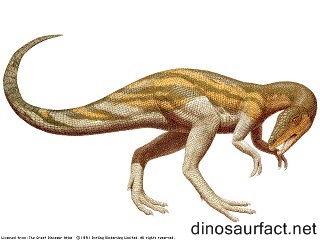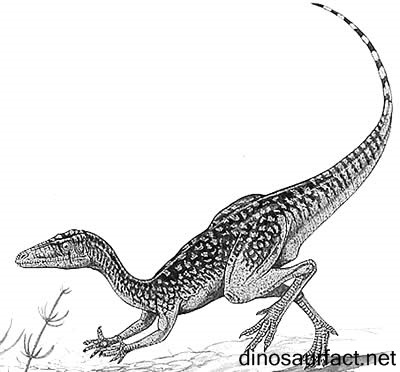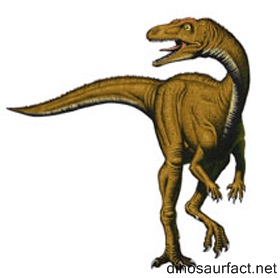 Click to visit the previous dinosaur bio
Click to visit the previous dinosaur bio
 |
|
 |
|
Kingdom: Animalia
Phylum: Chordata
Class: Sauropsida
Superorder: Dinosauria
Order: Theropoda
Suborder: Procompsognathinae
Family: Coelophysidae
Genus: Procompsognathus
 |
|
 |
|
 |
|

The Procompsognathus dinosaur lived in the forests of Western Europe. Remains of the dinosaur have been found in present day Germany. It was found in rock formations belonging to the Norian stage of the Upper Triassic.
The Discovery of Fossils
The poorly preserved skeleton fragments of the Procompsognathus were found in the middle Stubensandstein member of the Lowenstein Formation. This is a part of the quarry of Albert Burrer in the Stromberg region of in Wurttemberg, Germany. It was Albert Burrer who discovered these fossils in 1909.
The specimen consisted of three sandstone blocks. Out of them, the first one housed the broken remains of a skull and jaw bone. The second and third ones contained the postcranial skeleton which included neck, back and tail vertebrae, ribs, shoulder girdle, the hip bone, the pubic bones, a single forelimb and both hindlimbs.
Burrer then handed over the fossils to professor of Paleontology, Eberhard Fraas, who officially named the dinosaur Procompsognathus in 1913. The type species is Procompsognathus triassicus. The holotype specimen is SMNS 12591 and it is housed at the State Museum of Natural History at Stuttgart in Germany.
Frederick von Huene in 1921, added two more specimens to the species, the SMNS 12352 B & SMNS 12352a. These contain the partial remains of the skull and lower jaws, and an isolated left hand. These belonged to a larger individual than the holotype specimen.
Stubensandstein Formation and the Discoverers
The Stubensandstein is a prehistoric geological Norian age formation belonging to the Lowenstein area of Baden-Wurttemberg, Germany. It was an alluvial plain. The climate ranged from semi-dry to semi-humid in the Keuper Basin of South Germany. The quarry of Albert Burrer lies on the northern slopes of the Stromberg region near Wurttemberg. There were frequent volcanic eruptions in the area.
A variety of fossils have been found from the Stubensanstein including those of dinosaurs like Efraasia and Plateosaurus, Rausuchids like the Teratosaurus, and phytosaurs like Nircrosaurus.
The Norian age
The Norian is the middle stage or intermediate stage of the upper/late Triassic. It succeeds the Carnian stage and is succeeded by the Rhaetian stage. The Triassic is then followed by the Jurassic period. The Norian lasted between 228 and 208.5 million years of age.
Physical features and Automorphies
The Procompsognathus was a small sized dinosaur. It was approximately 3.3 feet in length and is estimated to have weighed about one kilogram. It had longer hind limbs and short fore limbs. The tibia is longer than the femur by roughly about 20 percent. This feature is an adaptation of cursorial habits in dinosaurs which means that the Procompsognathus was a fast runner.
The creature had long hands with well-developed claws. The snout was elongated and of medium build, with a large number of small teeth. The tail was more rigid than flexible.
Chatterjee in 1998, discovered and isolated some features in the Procompsognathus that he believed were automorphies. These include an accessory maxillary cavity is present in the skull, rotrally fused vomers that extend towards the choana, a transverse postorbital process in the lateroshenoida an enveloped of squamosal around the entire skull with no par occipital contact and the presence of fused orbitosphenoids.
Recent Analysis
The Procompsognathus was originally assigned to Dinosauridea by Frass. The term Procompsognathusidea was coined in 1923 by Franz Nopcsa . In 1932 von Huene classified the dinosaur as a member of the non-dinosaurian Pseudosuchia. It is common belief that the Procompsognathus is in fact, theropod dinosaur. Paul Sereno and Rupert Wild, In 1992 reported that that the holotype consisted of remains from two separate individuals: the postcranial part belonging to a theropod, likely a coelophysoid related to Segisaurus, and the skull and the von Huene specimens referred to the basal crocodylomorph Saltoposuchus . In 1993, Sankar Chatterjee after an extensive study refuted their claims and gave evidence that the skull was similar to that of a theropod like Syntarsus, and demonstrated that it was not a crocodylomorph, as it lacked the key features of this group. In 2004 David Allen reported Procompsognathus to be a basal, non-dinosaurian ornithodiran. Sereno (1997) and Ezcurra and Novas (2007) conducted phylogenetic experiments that supported the classification of Procompsognathus under the taxon Coelophysidae.
However the study of the referred specimens showed that these did not belong to the Procompsognathus. In 2012 Fabien Knoll conducted a CAT-scan and reaffirmed that SMNS 12352 was not a dinosaur but a crocodylomorph, although it was different from Saltoposuchus, unlike he had earlier reported.
Jurassic Park
Procompsognathus is featured in the novel Jurassic Park and the sequel The Lost World by author Michael Crichton.
About the Procompsognathus
The Procompsognathus is approximately 211 to 208 million years old, living in the Norian age of the Upper Triassic Period. It is one of the many European dinosaurs to have been identified and classified. The Procompsognathus has so been named after a previously discovered Jurassic dinosaur, the Compsognathus. Compsognathus is derived from Greek words which mean ‘elegant jaw’. The procompsognathus’ name thus translates to ‘before elegant jaw’, thus displaying a possible ancestry for the Compsognathus.
It was a small creature. Its ecological habitat was the dry, arid environment of Western Europe. It was bipedal and could run on its hind limbs. Forelimbs were well adapted for grasping its prey. It was in all probability a terrestrial creature. It was an agile animal and a carnivore. It used to hunt and eat smaller animals like insects, lizards and other small dinosaurs.
Although little is known about the dinosaurs, it has gained interest worldwide owing to its small built. It is the antithesis of how the world views dinosaurs as large, mammoth creatures. It is also one of the first dinosaurs, whose characteristics are still observed in modern day lizards and birds.
Thus the Procompsognathus in spite of being not so correctly studied, is one of the known dinosaurs. More can be known about these dinosaurs, if other skeletal remains, better-preserved and complete, are found. Until then, we have to believe what we know, even if it is speculation at best.
Index
Extinct Profiles
 Triassic Dinosaurs
Triassic Dinosaurs Jurassic Dinosaurs
Jurassic Dinosaurs Cretaceous Dinosaurs
Cretaceous Dinosaurs Pterosaurs
Pterosaurs Marine Reptiles
Marine Reptiles Dinosaur Extinction
Dinosaur Extinction